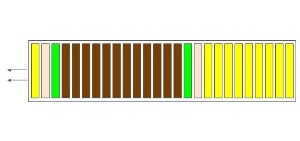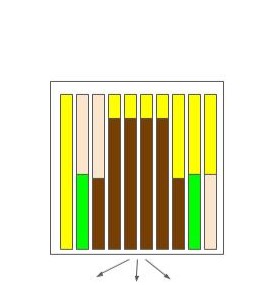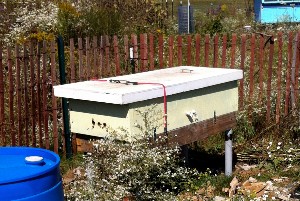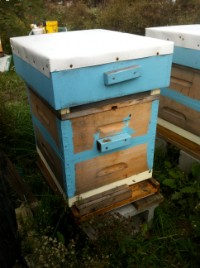
Alternatives to the Langstroth Double Deep
(or, beekeeping with more brains than brawn)
A double deep - or, two 9.25" deep boxes with 10 frames apiece - is the standard base equipment for beekeeping. It's common, so people aren't familiar with alternatives, it works well enough, and those have been "good enough" reasons to ignore its flaws. There are alternatives, and a growing population who post in bee chat rooms about their experiences with alternatives to the double deep. There are also an increasing number of e-books as well as print books available.

Pros to using 10 frame double deeps for the brood chamber
- The majority of books, clubs and classes discuss only the double deep. It can be daunting to try to adapt this wealth of information to an alternative approach.
- The majority of equipment for beekeeping - from hive bodies to insulation wraps - are sized for the Langstroth stacking box system.
- Multiple boxes offer more options for management.
- It is enough room in the early spring for incoming nectar and for the queen to lay.
- In winter, it holds enough honey for a very strong colony, without fear of starvation by spring.
Cons to using 10-frame double deeps for the brood chamber
- A deep full of honey is dangerously heavy (70 lbs). It needs to be moved periodically, even if it's full.
- People often do not inspect the bottom deep, which can prevent early detection of critical problems.
- Bees can get trapped into occupying the top box only. Then they store all their honey in the honey supers above the brood chamber- which might disappear come fall, when the honey is harvested.
- It is too much space for small colonies over the winter.
- It is too much space for the queen to fill over the summer, leaving the bottom box virtually unused for anything other than bees to hang out in.
Bees are bees no matter their container
Bees use their space in a consist manner, no matter its shape.
Brood will be laid next to the entrance;
honey will be stored deeper in the hive;
pollen and drone brood will be located at the sides of the brood nest.
But how much room does the queen need for the brood?
Now, time for some numbers:
- If the queen lays 2000 eggs a day,
- and a deep frame has room for around 4000 eggs, so in 2 days, she fills one frame,
- and it takes about 3 weeks until those eggs emerge,
- then the queen can fill about 10 frames with brood.
Even if the queen moves on to frame 11, frame 1 will then be empty, making for only 10 frames of brood total. So the queen will never fill an entire 20 frame double deep with brood; she might fill 12 frames. For those who have seen more than 12 deep frames filled with brood, I will bet dollars to doughnuts there were two queens coexisting in the hive. Some queens are more likely to do that.
Variations on the multiple-box brood nest (that I haven'te tried yet):
- 8 frame double deep: Bee supply stores have this gear. With the loss of 2 frames in each box, this becomes an easier lift for people.
- A 10-frame deep with an 10-frame medium. Pros: the top brood chamber is not as heavy (50 lbs when full of honey). Cons: can't swap frames between the top and bottom brood chamber.
- 3 eight frame mediums for the brood chamber.Pros: interchangeable frames for honey-storage and brood-production. Cons: 24 frames potentially to manage for the brood chamber.
- 2 ten frame mediums: May not be enough winter honey storage space, go 3 boxes or mandatory sugar box above the brood chamber for that season, but May-Sept, it will be just right.
All of these are managed in a way very similar to the Langstroth Double deep, and have many of
the same pros and cons. You can turn your 10 frame into an 8 frame, if you find it too heavy: Take a frame
without foundation, cut a piece of foam or cardboard and place inside the frame. You can wrap the foam
in aluminum foil. These frames go on the outside of the "real" frames.
Viola! Extra insulation AND it's lighter. Yes, this is less honey overall for the bees, and so,
you may benefit from 1) extra feeding in fall, and 2) a mandatory solid-sugar feeder above the hive
during winter, replenished as needed, kept on until reliable foraging arrives (in OH, that's May). Although actually,
your peace of mind will benefit the most - the bees will be fine when they are managed with care in any of these options.
You don't have to suffer through beekeeping with a too-heavy box of bees...
Above I have mentioned options for managing the "queen's apartment", where the queen lays brood, which is also the "winter quarters"
for the bees. 2020 is the first year I'm using a deep and a shallow as the brood chamber/winter quarters, more later!
But I have a lot of information about a long hive or top bar hive, which I used from 2016-2018, and had up to 6 hives overwinter. Successfully. All 6.
I also have a lot of information about using a Dadant deep, which is a single box for the queen (or winter) with 10 frames that are 12.75" tall.
A long hive or top bar hive
A long hive can work fine. Below is a schematic of how the bees use the hive. The baby bees occupy a horizontal space rather than a vertical one. Sothe queen moves sideways more than she is filling in up-and-down. It's a longer trip back to the open side of the brood nest, once the queen has filled an area to the end of the hive! But she manages fine. The honey is stored away from the entrance, and those frames are often not used for brood. .
Long hive, or top bar, 9 5/8"" tall

A Dadant deep, in a single 12 7/5" box with 10 frames, will house a more compact sphere, so the queen spends more time on one frame. In winter, this is also resulting in bees at the top of the hive and surrounded by full frames of honey on either side. A multiple box hive will have no bees at the top of the hive early in the winter, if they filled the hive with enough honey.
Dadant deep hive, 12 3/4"

I have management advice and building advice for top bar/horizontal hives and for the Dadant deep. My first foray into alternative hives was the Top Bar hive, which started to morph into a Long Hive with frames, then underwent its final conversion with the adoption of the Dadant Deep single brood chamber. Check it out!
Top Bar Hives - smooth and illuminating

Dadant Deep hives - single-chamber honeymakers
